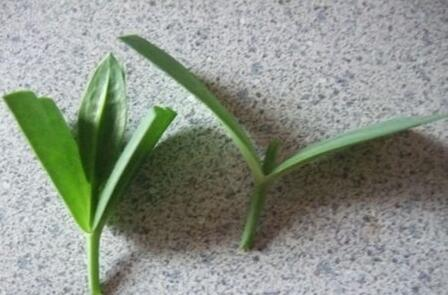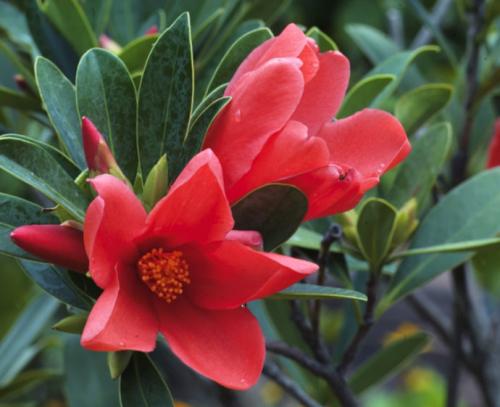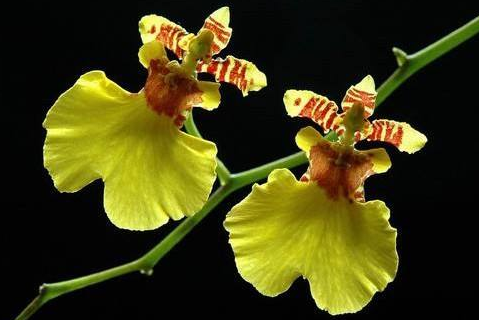Propagation method of Platycodon grandiflorum-cutting
Cutting of Platycodon grandiflorum: material selection
If you want the cuttage to be very successful, material selection is also very important. It is best to choose the part with strong meristematic ability in Platycodon grandiflorum, and you can choose the stem under the second pair of leaves under the heart leaves after jointing.
Do not choose the stems under the first pair of leaves under the heart leaves, because they are still relatively delicate and have high requirements for nutrients, so the survival rate is not high, which is not conducive to cutting.
It is best to choose cuttings with only one pair of leaves, which will increase the survival rate.
Cutting of Platycodon grandiflorum: cutting treatment
The cuttings are obliquely cut into small segments containing a pair of leaves. The purpose of oblique cutting is to increase the area of meristem for cutting stubble. In this way, the contact area is increased, which is more conducive to the cutting.
Then cut off half of each leaf, because at the beginning of the cuttage, because there is no root system, the nutrients needed are the original reserves. It can only be cut in half, not all of it, because there will be no photosynthesis.

Platycodon grandiflorum cutting: preparing substrate
Water is used to water the substrate before sowing to keep it moist.
The substrate is slightly alkaline and the pH value is maintained at 6 Mel 6.5. You can use peat plus some vermiculite and perlite, stir in some carbendazim, and then disinfect the substrate to prevent the growth of bacteria.
How to cut Platycodon grandiflorum? Cutting Propagation method of Platycodon grandiflorum
The most commonly used method for propagation of Platycodon grandiflorum is sowing method. In fact, in addition to sowing method, cutting method can also be used for propagation. However, because many flower friends do not master the correct method when cutting, the survival rate of Platycodon grandiflorum after cutting is not high. Below, we will bring you a practical method of cutting propagation of Platycodon grandiflorum, which can effectively improve the survival rate.
Picture: cutting propagation method of Platycodon grandiflorum
I. selection of materials
To choose the part of Platycodon grandiflorum with strong meristematic ability, it is best to have stronger meristematic ability of the stem under the second pair of leaves under the heart leaves after jointing, so the selection is very important for cuttings. The stem under the first pair of leaves under the heart leaf is more delicate and requires higher nutrients, so the survival rate is slightly lower. It is best to choose cuttings with only one pair of leaves, and the survival rate will increase.
Second, cuttings treatment
The cuttings are obliquely cut into small segments containing a pair of leaves. The purpose of oblique cutting is to increase the area of meristem for cutting stubble. Then cut off half of each leaf, because at the beginning of cutting, because there is no root system, the nutrients needed by cuttings are originally stored, cutting half of the leaves can reduce the consumption of nutrients, more conducive to rooting. But not all the leaves can be cut off, so that cuttings can not carry out photosynthesis, unable to produce nutrients.
III. Prepare the matrix
The substrate is slightly alkaline and the pH value is maintained at 6 Mel 6.5. You can use peat plus some vermiculite and perlite, stir in some carbendazim, and then disinfect the substrate to prevent the growth of bacteria. Water the substrate thoroughly before sowing to keep it moist.
Picture: cutting propagation method of Platycodon grandiflorum
IV. Concrete steps
1. Insert a small hole in the basin soil with chopsticks or sticks and put the cuttings into
two。 Compacted the basin soil with your hands and watered it thoroughly.
3. Cover the film or transparent lid and put a few small holes in it to breathe.
4. Put the flowerpot in a bright but low temperature place, which can accept direct sunlight in winter and early spring.
5.The film or plastic lid can be removed after 10 days, and the cuttings can take root in 5 weeks. When the cuttings take root to a certain extent, the aboveground parts begin to sprout.
6. When the new bud grows the second pair of leaves, it can be transplanted, and normal maintenance can be carried out at this time. The above is about the introduction of cutting propagation methods of Platycodon grandiflorum. Platycodon grandiflorum likes warm, moist and sunny environment, which is more drought-resistant and not water-resistant, so we need to pay special attention to it in the maintenance process.
How to propagate, sow and cuttage of Platycodon grandiflorum
How to propagate Platycodon grandiflorum, Platycodon grandiflorum can propagate through seed sowing and branch cutting, then understand the cutting and seed sowing methods of Platycodon grandiflorum respectively.
How to propagate Platycodon grandiflorum 1. The method of cuttage propagation a, branch selection
Be sure to choose the more robust ones from the adult plants, which can effectively increase the success rate.
B. Cutting method
First of all, choose the planting soil, then use a stick to insert a hole in the soil to put the cuttings in, then bury it with the soil, then pour the water thoroughly, and cover the top layer with plastic wrap.
In order to maintain the breathability, insert a few small holes in the plastic wrap, and then put it in a place with light. The membrane can be removed in more than a week, and the cuttings will take root in a month.
2. Seed sowing method a, soil selection
Platycodon grandiflorum seed sowing, the soil generally choose peat-based, and then add a little larger perlite and other soil, which can increase water permeability and air permeability, and then add some disinfectant for disinfection.
B, seed sowing mode
After sowing the seeds into the planting soil, there is no need to cover the seeds with a layer of soil. Generally, the temperature of germination needs to be controlled at about 24 degrees Celsius, and then the seeds can be seen to sprout in about half a month. After sprouting, it is necessary to keep the sun full, and the basin soil can be a little wet, but not stagnant water.
C, planting on the basin
When Platycodon grandiflorum slowly grows four or five leaves, it can be planted, and several can be planted, so that it will look very good when it blossoms in the future. Generally speaking, flowerpots with a diameter of about 21 centimeters can plant five Platycodon grandiflorum. After Platycodon grandiflorum is put on the pot, you must remember to apply fertilizer to help the development.
- Prev

Steps of Camellia Cuttage
Step 1 choose sandy soil with loose soil and good drainage, usually a mixture of perlite and coarse sand or vermiculite. Step 2: select the well-developed branches, usually the twigs are longer and the thick branches are shorter, and then cut them along the cutting point.
- Next

Propagation methods of Oncidium
The ramet propagation of Oncidium is a kind of compound-stemmed orchid. Mature plants will have seed plants, and ramet propagation needs to wait for the pseudobulbs of the seed plants to grow. Generally speaking, the false bulb with two buds is cut off and planted directly in a basin with water moss to keep it moist, which can better promote root growth.
Related
- Fuxing push coffee new agricultural production and marketing class: lack of small-scale processing plants
- Jujube rice field leisure farm deep ploughing Yilan for five years to create a space for organic food and play
- Nongyu Farm-A trial of organic papaya for brave women with advanced technology
- Four points for attention in the prevention and control of diseases and insect pests of edible fungi
- How to add nutrient solution to Edible Fungi
- Is there any good way to control edible fungus mites?
- Open Inoculation Technology of Edible Fungi
- Is there any clever way to use fertilizer for edible fungus in winter?
- What agents are used to kill the pathogens of edible fungi in the mushroom shed?
- Rapid drying of Edible Fungi

